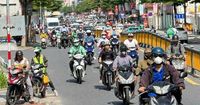On the bustling streets of Da Nang, Vietnam’s coastal city renowned for its beaches and dynamic urban life, a new conversation is taking shape—one that could change the very air its citizens breathe. Over the past week, Da Nang’s Department of Construction has responded publicly to growing calls from residents to convert gasoline-powered motorcycles to electric models, especially in areas choked with traffic. This move, city officials say, is not just about keeping up with the times; it’s about tackling urban pollution head-on and reimagining the city’s future.
According to reports from Bao Giao Thong and Dân trí, the city’s consideration of a large-scale switch from gasoline to electric motorcycles comes at a moment when environmental concerns are at the forefront of national policy. On July 12, 2025, Vietnam’s Prime Minister issued Directive No. 20/CT-TTg, laying out urgent and decisive measures to combat environmental pollution. Da Nang, often hailed as a “green, clean, and beautiful” city, now finds itself at the heart of this directive’s implementation.
The Department of Construction’s response, issued on August 16 and 17, 2025, acknowledges the public’s desire for cleaner air and less noise. Residents have specifically suggested that the city should prioritize converting gasoline-powered motorcycles to electric ones in high-traffic central districts. The rationale is clear: electric motorcycles emit no tailpipe pollutants and are significantly quieter, helping to create a more peaceful and healthier urban environment. As Dân trí notes, supporters believe the shift will "improve quality of life as well as support sustainable tourism development."
This isn’t just wishful thinking. Da Nang has already begun researching and drafting detailed plans to gradually phase out gasoline motorcycles in favor of electric alternatives. The Department of Construction emphasized that this initiative aligns with both local aspirations and national policy priorities. "This is an issue that the Government, the Prime Minister, and relevant authorities have paid special attention to in recent years," the Department stated, as reported by Bao Giao Thong.
But what will this transition actually look like? City officials have outlined a multi-pronged approach. First, they are developing a specific roadmap for the conversion, one that takes into account Da Nang’s unique socio-economic context and the readiness of its people and businesses. The city is also considering financial support policies to help citizens and companies make the switch. This could mean subsidies, low-interest loans, or other incentives—though the details are still under study.
Infrastructure is another key pillar. The city plans to ramp up the development of charging stations, both in public spaces and residential areas. After all, the convenience of recharging electric motorcycles is crucial if the transition is to succeed. As KTCK highlights, establishing a robust network of public charging points in central districts, neighborhoods, and parking lots is seen as a "necessary condition for people to conveniently use electric vehicles, thereby encouraging the conversion process."
Community engagement is also front and center. The Department of Construction has pledged to "increase public awareness about the benefits of electric motorcycles," recognizing that technology alone won’t drive change—people must see the value in adopting new habits. Campaigns to educate residents about the environmental and health benefits of electric vehicles are in the works, aiming to foster widespread support for the initiative.
Why the urgency? Da Nang’s streets are packed with motorcycles—like many Vietnamese cities, two-wheelers are the backbone of daily transport. But with that convenience comes a heavy price: air pollution from gasoline engines, noise from exhaust pipes, and a general decline in urban tranquility. The Department of Construction, in its public responses, has repeatedly stressed that converting to electric motorcycles will "reduce CO2 and dust emissions, limit engine noise, and create a quieter and cleaner living space," as reported by KTCK.
There’s also a strategic angle. Da Nang is positioning itself as a model for smart, sustainable urban development. By embracing clean transportation, city leaders hope to not only improve public health but also enhance Da Nang’s appeal as a destination for tourists and investors. The city’s image as a "dynamic, modern, and sustainable" metropolis is at stake, and officials are keen to integrate the conversion plan into broader urban development and long-term planning programs.
Of course, the transition won’t happen overnight. Authorities acknowledge the complexity of converting an entire city’s motorcycle fleet. That’s why the roadmap under consideration will be phased, starting with central areas where traffic is densest and pollution is most acute. The plan is to "build a detailed conversion roadmap suitable to the city's socio-economic conditions and the readiness of residents and businesses," the Department told Bao Giao Thong.
Financial support is another piece of the puzzle. The city is studying policies to "encourage the transition to electric vehicles, especially electric motorcycles," recognizing that upfront costs could be a barrier for many. While specifics have yet to be announced, such measures are expected to include both direct subsidies and broader incentives for manufacturers and consumers alike.
Coordination across government departments is essential. The Department of Construction has committed to working closely with other agencies to "research and propose feasible solutions, integrating them into the city's development programs and projects in the near future," as stated in multiple reports. This collaborative approach is seen as key to ensuring that the transition is both practical and sustainable.
The public, for its part, seems ready for change. Many residents, according to Dân trí, see the conversion as a way to "enhance the city’s image and support the development of sustainable tourism." The hope is that cleaner, quieter streets will not only make life better for locals but also attract more visitors looking for a modern, environmentally conscious destination.
As Da Nang moves forward, it faces both opportunities and challenges. The city must balance the need for swift action on pollution with the realities of economic and social transition. Yet, with strong public support, clear government commitment, and a growing sense of urgency, Da Nang’s journey toward a cleaner, greener transportation future seems well underway. The next few years will reveal just how quickly—and successfully—this ambitious vision can become reality.




